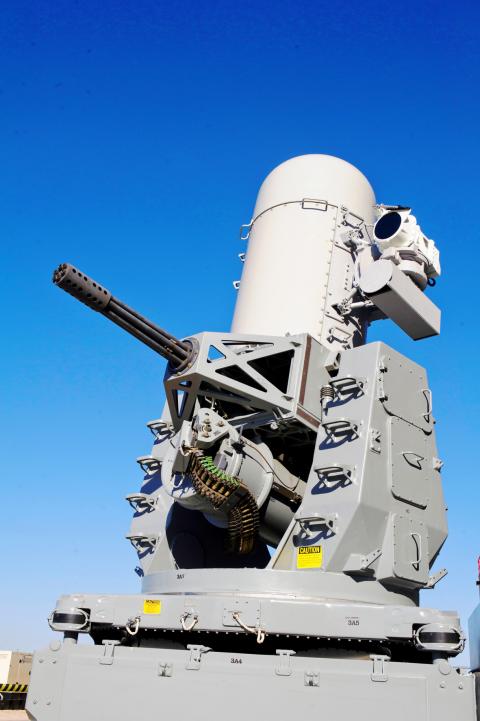Taiwan has accepted part of an arms deal package offered by the US that includes 13 sets of Phalanx close-in weapons systems (CIWS) and other equipment that will cost NT$9 billion (US$286.6 million), Ministry of National Defense sources said yesterday.
The US in December last year extended a letter of offer and acceptance to Taiwan for an arms package costing about US$1.83 billion.
The package included two decommissioned FFG-7 Oliver Hazard Perry-class guided missile frigates, 36 AAV-7 amphibious assault vehicles, 13 MK 15 Phalanx Block 1B ship defense CIWS and upgrade kits, ammunition and support, 250 Block I-92F MANPAD Stinger missiles and other equipment.

Screen grab from the Raytheon Co Web site
Taiwan agreed to buy the frigates in March, the AAV-7 vehicles in May and the Phalanx CIWS last month, the source said.
The CIWS is considered standard equipment on all surface combat ships, the source said, adding that the ministry has deployed the systems in mountainous areas to enhance security at missile bases.
Prior to the signing of the offer last month, the navy had only one MK 15 Block 1B CIWS system on one of its Kidd-class destroyers, the source said.
The MK 15 system is more advanced than the Phalanx systems currently in the Taiwanese arsenal, with the addition of visible light/infrared targeting systems and the ability to switch to manual mode, increasing a surface combat ship’s counterstrike abilities, the source said.
Ministry officials said that delivery of the new systems is expected to be a drawn-out process, with the navy not likely to receive the last batch until June 2024.

The US government has signed defense cooperation agreements with Japan and the Philippines to boost the deterrence capabilities of countries in the first island chain, a report by the National Security Bureau (NSB) showed. The main countries on the first island chain include the two nations and Taiwan. The bureau is to present the report at a meeting of the legislature’s Foreign Affairs and National Defense Committee tomorrow. The US military has deployed Typhon missile systems to Japan’s Yamaguchi Prefecture and Zambales province in the Philippines during their joint military exercises. It has also installed NMESIS anti-ship systems in Japan’s Okinawa

‘WIN-WIN’: The Philippines, and central and eastern European countries are important potential drone cooperation partners, Minister of Foreign Affairs Lin Chia-lung said Minister of Foreign Affairs Lin Chia-lung (林佳龍) in an interview published yesterday confirmed that there are joint ventures between Taiwan and Poland in the drone industry. Lin made the remark in an exclusive interview with the Chinese-language Liberty Times (the Taipei Times’ sister paper). The government-backed Taiwan Excellence Drone International Business Opportunities Alliance and the Polish Chamber of Unmanned Systems on Wednesday last week signed a memorandum of understanding in Poland to develop a “non-China” supply chain for drones and work together on key technologies. Asked if Taiwan prioritized Poland among central and eastern European countries in drone collaboration, Lin

NO CONFIDENCE MOTION? The premier said that being toppled by the legislature for defending the Constitution would be a democratic badge of honor for him Premier Cho Jung-tai (卓榮泰) yesterday announced that the Cabinet would not countersign the amendments to the local revenue-sharing law passed by the Legislative Yuan last month. Cho said the decision not to countersign the amendments to the Act Governing the Allocation of Government Revenues and Expenditures (財政收支劃分法) was made in accordance with the Constitution. “The decision aims to safeguard our Constitution,” he said. The Constitution stipulates the president shall, in accordance with law, promulgate laws and issue mandates with the countersignature of the head of the Executive Yuan, or with the countersignatures of both the head of the Executive Yuan and ministers or

CABINET APPROVAL: People seeking assisted reproduction must be assessed to determine whether they would be adequate parents, the planned changes say Proposed amendments to the Assisted Reproduction Act (人工生殖法) advanced yesterday by the Executive Yuan would grant married lesbian couples and single women access to legal assisted reproductive services. The proposed revisions are “based on the fundamental principle of respecting women’s reproductive autonomy,” Cabinet spokesperson Michelle Lee (李慧芝) quoted Vice Premier Cheng Li-chiun (鄭麗君), who presided over a Cabinet meeting earlier yesterday, as saying at the briefing. The draft amendment would be submitted to the legislature for review. The Ministry of Health and Welfare, which proposed the amendments, said that experts on children’s rights, gender equality, law and medicine attended cross-disciplinary meetings, adding that